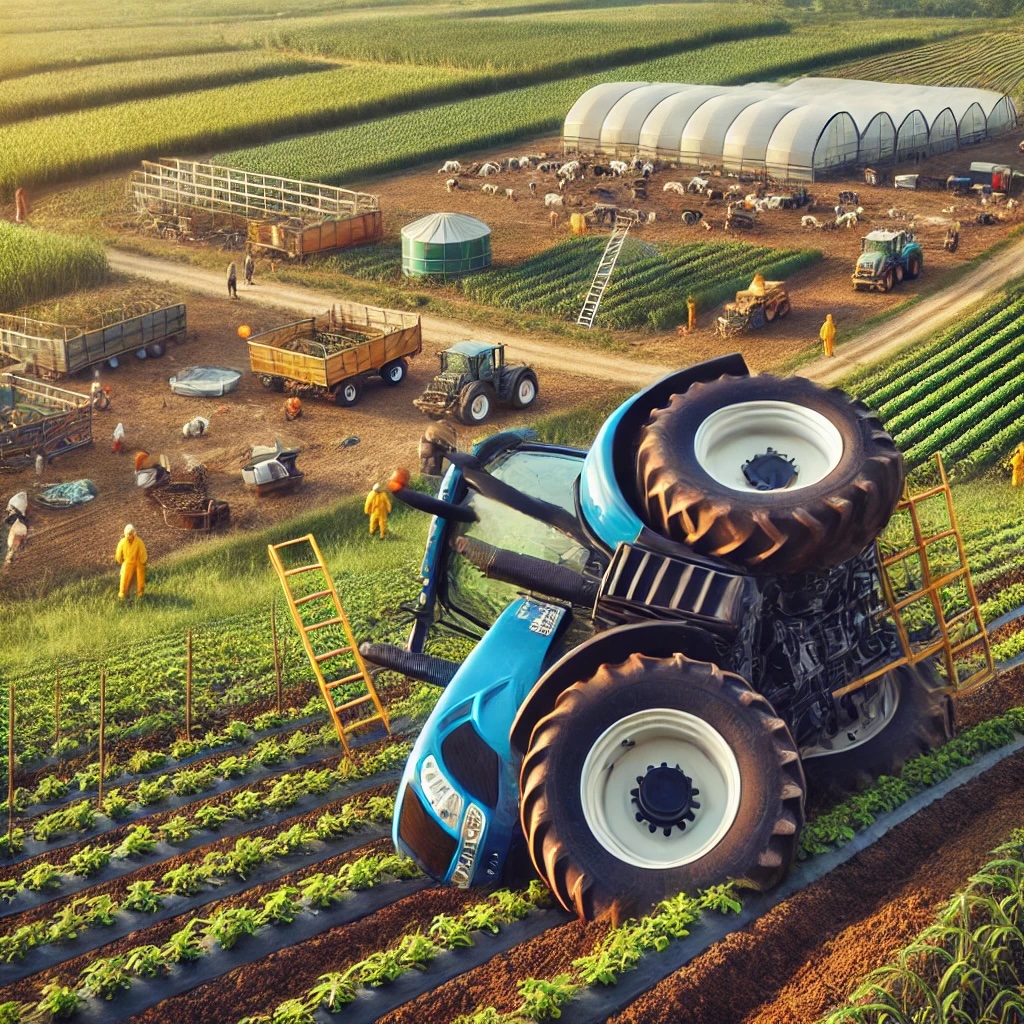Understanding Agriculture-Related Industrial Accidents: Key Statistics, Common Incidents, and Prevention Strategies
Agriculture is a vital industry that feeds populations worldwide, but it also poses significant risks to those working within it. Agriculture-related industrial accidents are unfortunately common and can lead to severe injuries or fatalities. In this blog post, we’ll explore the key statistics surrounding these accidents, the most common types, and how they can be prevented.
Key Statistics on Agriculture-Related Accidents
Agriculture consistently ranks as one of the most hazardous industries. According to the U.S. Bureau of Labor Statistics (BLS), agriculture, forestry, fishing, and hunting sectors recorded a fatality rate of 23.1 deaths per 100,000 workers in 2023, making it one of the deadliest sectors in the country. This rate is significantly higher than the national average across all industries, which is about 3.5 per 100,000 workers.
Non-fatal injuries are also common in agriculture. In 2022, there were approximately 20,000 reported cases of agricultural workers experiencing non-fatal injuries. Many of these injuries lead to lost workdays, decreased productivity, and significant medical costs.
Globally, the situation is no better. The International Labour Organization (ILO) estimates that around 170,000 workers die each year due to occupational hazards in agriculture, forestry, and fishing. These alarming statistics highlight the need for improved safety practices and preventative measures in the industry.

Most Common Types of Agriculture-Related Accidents
Agricultural workers face various risks due to the nature of the job, which involves heavy machinery, large animals, hazardous chemicals, and exposure to harsh environments. The most common accidents in agriculture include:
- Tractor and Machinery Accidents
- Tractor rollovers are among the leading causes of death and serious injury in agriculture. Rollovers can happen if the vehicle is not properly balanced, if the terrain is uneven, or if safety features like rollover protection systems (ROPS) are not in place.
- Machinery entanglements occur when clothing, limbs, or other body parts are caught in moving parts of equipment, such as augers, balers, or combines.
- Falls from Heights
- Workers often perform tasks on ladders, silos, or haylofts, which present risks of falling. Falls are a leading cause of injury, particularly for tasks performed without proper fall protection systems in place.
- Animal-Related Injuries
- Farmers who work with livestock face risks from unpredictable animal behavior. Injuries from kicks, bites, or being crushed by larger animals such as cattle or horses are common.
- Chemical Exposure
- Pesticides, fertilizers, and other agrochemicals can cause severe skin irritations, respiratory problems, and long-term health conditions if mishandled or used without proper protective equipment.
- Heat Stress and Environmental Hazards
- Agricultural workers often endure long hours in extreme weather conditions. Prolonged exposure to the sun and high temperatures can result in heat stroke, dehydration, and heat exhaustion, while cold environments can lead to frostbite and hypothermia.
Prevention Strategies for Agriculture-Related Accidents
Reducing accidents in the agriculture industry requires a proactive approach to worker safety. Implementing preventive strategies can significantly mitigate risks and enhance workplace safety. Here are some key measures:
- Use of Proper Equipment
- Ensuring that tractors and other machinery are equipped with Rollover Protection Structures (ROPS) can reduce fatalities by up to 99% in the event of a rollover.
- Regular maintenance and inspection of machinery to ensure all parts are functioning properly can prevent mechanical failures and accidents.
- Training and Education
- Regular safety training for agricultural workers is essential. Workers should be trained to operate machinery safely, handle chemicals properly, and recognize the early signs of heat-related illnesses.
- Farmers should also receive education on proper techniques for working with animals, minimizing risks of injury.
- Protective Gear
- Providing Personal Protective Equipment (PPE), such as gloves, helmets, protective eyewear, and respirators, is critical when working with chemicals, machinery, or in hazardous environments.
- Using safety harnesses and fall protection systems when working at heights can prevent serious fall-related injuries.
- Safe Handling of Chemicals
- Proper storage and labeling of chemicals are crucial to avoid accidental exposure. Workers should always follow the manufacturer’s safety instructions and use PPE when handling hazardous substances.
- Investing in chemical training programs can teach workers how to minimize risks and respond appropriately to exposure incidents.
- Heat and Environmental Stress Management
- Employers should provide shaded areas, adequate water supplies, and scheduled breaks during hot weather to help prevent heat stress.
- Implementing heat illness prevention programs can reduce risks associated with extreme weather exposure.
- Animal Safety Protocols
- Establishing protocols for safely handling livestock, including the use of gates, barriers, and proper positioning when working with large animals, can prevent injuries from kicks or crush accidents.
- Emergency Response Planning
- Every farm should have an emergency response plan that includes procedures for dealing with machinery accidents, chemical spills, and other emergencies. Having first-aid kits and trained personnel on-site can make a significant difference in reducing the severity of injuries.
Conclusion
Agriculture is an inherently hazardous industry, but by recognizing the most common types of accidents and implementing comprehensive prevention strategies, farmers and workers can significantly reduce the risks they face on the job. From tractor rollovers to heat stress, every aspect of farm work comes with its own set of challenges. However, with proper training, equipment, and safety protocols, the agricultural sector can become a safer environment for the millions of people it employs worldwide.
By staying informed and committed to safety, agricultural workers and employers alike can make strides towards reducing accidents and creating safer work environments for everyone involved.